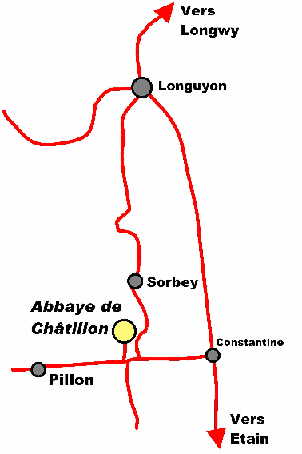






|
Story of the Abbey of Châtillon.... |
|
Albéron of Chiny, bishop of Verdun, connected by friendship with saint Bernard, wanted to establish the religious Cistercians in several places of his diocese. Having called to Chalade the monks of Three Fountains, he addressed Radulfe, abbot of Himmérode, in the diocese of Armistices, and obtained from it from monks, who came, in 1142, to begin the construction of a monastery in a place conscript le Chastelet or Châtillon, on the small river of Othain near the villages of Sorbey and Pillon ( Meuse ). |
|
After a try of some years, they found insufficient, to remain of the work of the hands, the ground there which a nearby Lord had given them. The bishop Albéron, by a charter of 1153, offered them the other vaster places in the forest of Mangiennes and confirmed donations made by several Lords; they became established in a place named Viberstap (farm of Bois-les-moines) another monastery, where they entered the day before the Christmas of Notre-Dame in 1153. The general Chapter of Citeaux gave the same year the title of abbey to the new foundation, and Gilbert, one of the monks, is elected first abbot. After a stay in this place of nine years, in 1162, the monks, forced to abandon Viberstap, especially because of the insalubrity of waters, returned, in their first establishment and, settled definitively in Châtillon where they stayed during more than six centuries. New abbey and its church were from the very beginning, according to the usage of the Cistercians, placed under the patronage of Notre-Dame. |
|
The monks worshipped in their church a former stone statue of the Virgin Mary, their saint; they attributed to her protection of numerous favours, obtained in disasters, in 1622, 1636, etc... We came in pilgrimage there. |
|
The buildings of the abbey included: the abbatial district or the lodging house of the abbot, situated below in the entrance of the monastère; near there, the housing of the doorman; - the convent and the very former convents, the room of the Chapter, several rooms and the anterooms, the dining hall, the kitchen, etc.; - in the 1st floor, the vast room, the beautiful dormitory, at least eleven cells for monk, and two for brothers lay, etc. The novices lived in a part of the convent. The lodging house of the hosts was big and convenient. In the Farmyard were the houses of the farmer and the domestics. Besides the sheds there was cooperage, brewery, oil-works, etc. Finally vast gardens surrounded the monastery. |
|
The coat of arms of the abbey was: “of azure in a tower of gold or silver built by sand”. |
|
The monks of Châtillon possessed several houses and several farms to Pillon; a forge to Longuyon; - mills to Allondrelle, Arrancy, Huaut, Moraigne, Nouillonpont, Sorel; - a tilery and a farm in the Blast furnace; - farms and lands on the finages of Dommary , Dampicourt, La Haute-Voile, Houdelaucourt, Lopigneul, Petit-Xivry, Réchicourt, Solry, Sorbey, Sorel, Avillers, Duzey, Gouraincourt, Handeville, Rampont, Saint-Laurent, Saint-Pierrevillers, Grand-Failly, etc. |
|
The abbey also possessed wood in Châtillon, to Sorbey, etc. |
|
It was entitled to portions of tithes on the terrages of Beuveille, Billy, Dampicourt, Mont-Quintin, Houdelaucourt, Petit-Xivry, Sorbey, Villers-la-Montagne, Torgny, Dommary, Duzey, etc. |
|
In the revolution, on January 30th, 1791, we sold the furniture of the abbey and the cattle of stables. |
|
Plan of situation |
